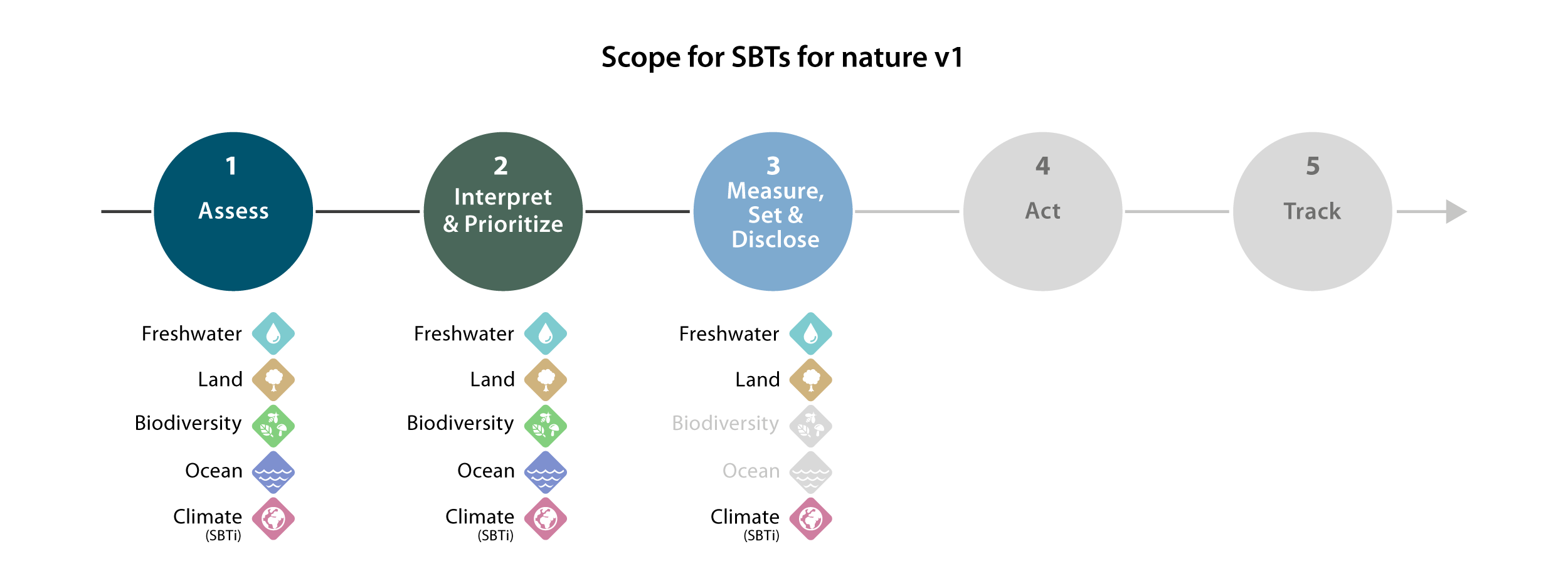Public consultation for the first land science-based targets
Coming soon, the first release of science-based targets for nature will help companies adopt a roadmap for integrated action on nature and climate. They will equip companies to assess and prioritize their environmental impacts and progress to setting land and freshwater targets.
Ahead of this release, the Science Based Targets Network (SBTN) sought public comment on its draft methodologies for companies to set the first land science-based targets – focusing on the protection and restoration of ecosystems. The public consultation period ran from February 14 – March 21, 2023.
This public consultation marked a critical point in the development of the land targets. It was the public’s opportunity to provide input into the Network’s multi-stakeholder process to ensure the finalized guidance for companies is as robust, clear and practical as possible, when released as part of the first science-based targets for nature.
VIEW DRAFT GUIDANCESupporting a nature-positive future
Land science-based targets build and complement climate science-based targets by incentivizing corporate action beyond reducing greenhouse gas emissions to addressing the overall needs of the environment. This approach will lead to a holistic outcome that benefits the climate, nature and society.
Adoption by companies of these land targets will be a leap forward in voluntary corporate accountability by bringing working lands – 64% of Earth’s habitable land – into the environmental agenda.
While firmly rooted in directing companies to assess, avoid, or mitigate their impacts on nature, these targets intend to go further by incentivizing companies to deliver on regenerative, restorative, and transformative actions in land systems—including those that underpin broader issues of sustainable development and that are in line with a nature-positive future.
Building on existing and emerging sustainability frameworks and initiatives, these first land science-based targets aim to be a significant step forward in corporate ambition, ahead of expanded and complementary ones in subsequent releases.
VIEW DRAFT GUIDANCEPeople have transformed between a third to half of all habitable land into farms, crops and pastures, causing harm to vital ecosystems that are essential to our survival. Land degradation and soil degradation could result in a massive economic loss of up to $11.2 trillion in agricultural assets, putting the cornerstone of many companies’ businesses in jeopardy. Aside from the moral imperative to act, companies who implement science-based land protection and restoration efforts will be frontrunners in managing the significant risks and opportunities related to their environmental impacts and dependencies including business resilience, brand value, access to capital and forthcoming policy and regulations.
Between February 14 – March 21, SBTN welcomed input from external stakeholders that could inform the finalization of the draft methods including companies, financial institutions, consultancies, industry associations, NGOs, academics and policy-makers. Due to the technical nature of this content, stakeholders with expertise in sustainability, environmental risk management, environmental and social science, ecology and conservation are appreciated.
SBTN’s land hub – a group of technical experts collaborating from across the Network – has developed the V1 land methods over the past year. The land hub is co-led by WWF and Conservation International with partners Food and Land Use Coalition, Systemiq, The Nature Conservancy and World Resources Institute. Their work has been funded by the Gordon and Betty Moore Foundation, Norway’s International Climate and Forest Initiative and The Robert Bosch Stiftung.
The land methods have undergone a multi-stakeholder consultation process including informal consultations with companies and consultancies, primarily through SBTN’s Corporate Engagement Program with over 110 companies, as well as with representatives from the scientific community and civil society through a formal internal consultation, before proceeding to this public consultation
In addition, SBTN methods and tools are typically tested by at least a handful of companies for feasibility. For the land targets, a number of companies in 2022 piloted the CAMEL tool developed to support impact baselining for land targets
As part of SBTN’s governance model, the land methods were submitted to an Expert Review Panel (ERP) before the end of Q4 2022. The ERP provides a recommendation on whether the methods are fit for publication by assessing it against technical criteria to understand whether the guidance will lead to positive environmental and societal outcomes, when companies apply the methods correctly.
Version 1 of the land science-based targets for nature comprise three distinct targets, which companies should adopt depending on the materiality of pressures generated by the company’s activities, as well as the sector and size of the company:
- No Conversion of Natural Ecosystems
- Land Footprint Reduction
- Landscape Engagement
These targets are designed to work together to incentivize the high level actions needed to achieve nature goals in land systems – namely halting conversion of natural ecosystems (target 1), freeing up land for natural ecosystem restoration (target 2) and improving the ecological integrity of landscapes, including working lands, to enhance ecosystem structure, composition and function (target 3). Critically, the landscape engagement target (target 3) works to avoid unintended consequences of targets 1 and 2, for example to prevent companies from shifting towards intensive agricultural production methods which are high yielding in the short term but which lead to degradation and further conversion of natural ecosystems in the long term. It also provides a vehicle to guide the implementation of the other two land science-based targets through landscape level engagement.
These targets are based on the information and data that is currently available so companies can begin to take action now. Companies first assess their impacts on several key components of land (using the SBTN guidance for Step 1: Assess and Step 2: Interpret & Prioritize) and then proceed to set targets that will allow for quantifiable contributions at the company and landscape level.
As land system science and methods for accounting for impacts and dependencies on nature progress, more comprehensive targets will be released as part of science-based targets for nature V2 by the end of 2024.
Specifically, the SBTN Land Hub is working over this period to quantify spatially explicit thresholds that define what nature needs to thrive and to quantify the ecological limits of human modification and use of terrestrial land systems that will form the basis of the second version of the methods for the land science-based targets.
- No Conversion of Natural Ecosystems: Land Use Change (LUC) is one of the primary drivers of recent and historical biodiversity loss. This target limits further loss of biodiversity because of conversion of natural ecosystems attributed to company activities or sourcing. This corporate target supports global targets 1, 2, 3, 10, 11, 15, 16, 19, 20, 21 of the Kunming-Montreal Global Biodiversity Framework.
- Land Footprint Reduction: This target frees up agricultural land from production, relieving agricultural pressures on biodiversity. The implementation of this target asks companies to explore ecosystem restoration in agricultural areas taken out of production. This corporate target supports global targets 2, 3, 10, 15, 19, 20, 21 of the Kunming-Montreal Global Biodiversity Framework.
- Landscape Engagement: This target encompasses a variety of potential actions that companies can implement for achieving holistic environmental and social outcomes within collaborative landscape initiatives. Specifically, companies must substantially increase ecological integrity within priority landscapes for production and sourcing of high impact commodities (measured using the Ecological Integrity Index). In addition to the biophysical impacts of this target on GBF objectives, it promotes company engagement in the transformational processes necessary to realize landscape objectives. This corporate target supports targets 2, 3, 10, 11, 15, 16, 19, 20, 21, 22, 23 of the Kunming-Montreal Global Biodiversity Framework.
Land science-based targets are designed to increase the clarity, ambition, and/or scope of existing initiatives that, despite intent, have not led to the transformational changes required to address climate change and nature loss. They link to and build upon existing and emerging initiatives and frameworks and are not intended to lead to parallel or asynchronous processes that confuse or undermine existing, quality work on corporate sustainability.
In this version, the land targets will further quantify the specific contributions that companies can make to reduce their impacts on land and to contribute to a nature positive future by 2030. To achieve this, the targets reflect an integrated approach to target setting, accounting, and reporting. The first version of these land targets is built upon and written in collaboration with the experts and institutions that developed key existing data and environmental initiatives that cover land related impacts, namely:
- The Greenhouse Gas Protocol (GHGP) Land Sector and Removals Guidance
- Science Based Targets initiative’s Forest, Land and Agriculture (FLAG) Guidance
- The Accountability Framework Initiative (AFi)
The development of the land targets in connection with the above listed initiatives helps ensure alignment, strengthens the target approaches, and reduces the burden for companies, who are already working or will work with these initiatives.
The SBTi Forest, Land and Agriculture (SBTi FLAG) target setting methodology is based on land-related greenhouse gas emissions and removals. The focus is therefore on climate change and the actions companies take to address these emissions will maximize emissions reductions and removals. It also includes a requirement for companies to set a no-deforestation target and a recommendation for companies to set a no-conversion target.
The suite of the land science-based targets have a wider focus on what nature needs, for example, the landscape engagement target requires companies to increase ecosystem integrity within priority landscapes for production and sourcing of high impact commodities and the no conversion of natural ecosystems target more explicitly addresses non-forest natural ecosystems which are critical biodiversity habitats.
While there is a significant overlap in terms of the actions on land that companies would take to deliver against their science-based targets for land-related GHGs and removals (i.e. climate) and nature, the integration of climate and nature at the goal-setting level incentivizes more holistic approaches over singular “silver bullet” approaches that maximize the outcome of one indicator. For example, a climate-only lens might lead to fast-growing, monoculture, non-native tree planting for rapid carbon sequestration where land is relatively cheap (i.e. the biodiversity-rich tropical belt). This may have disastrous impacts on water availability, biodiversity loss and resilience in a region which would likely undermine climate outcomes due to increased wildfires, pests and disease.
Science-based targets for nature V1, which these land methods will be part of, focus primarily on enabling companies to assess and set targets on environmental impacts occurring within their direct operations, and upstream value chains (one component of Scope 3).
It does not address environmental impacts occurring in companies’ downstream value chains. As we expand the scope of the guidance in subsequent releases, environmental impacts in companies’ downstream value chains will be considered.
At a high level, companies should adopt each of the three land science-based targets depending on:
- The materiality of specific pressures generated because of the company’s activities
- The sector of the company
- The size of the company
- The impact of the company in terms of emissions and/or the land occupation footprint.
The draft guidance includes decision trees for each of the targets to enable companies to establish whether targets are a) required, b) recommended, c) not required, d) not applicable.
Depending on these factors, companies in or sourcing from a range of sectors will be required or recommended to set land SBTs including (but not limited to): food, beverage and agriculture, forestry, fishing and aquaculture, bioenergy, mining, infrastructure, accommodation, construction etc.
Once finalized, the land science-based targets will be included in SBTN’s first release of science-based targets for nature, coming soon in 2023. Companies will then be able to:
- Assess (Step 1): identify which environmental issues to set targets on, for which parts of the business
- Prioritize (Step 2): prioritize which places and parts of the business to get started on first
- Set Targets (Step 3): take action on specific material environmental issues, starting with targets on the protection and restoration of land ecosystems as well as freshwater quantity and quality (nitrogen and phosphorus initially).

Until this guidance is finalized and incorporated into the release of science-based targets for nature v1, the recommended starting point for companies as well as consultants, industry coalitions or other organizations looking for guidance on the target-setting journey is SBTN’s no regrets actions including assessing their impacts on nature loss through SBTN’s Initial Guidance published in 2020.


